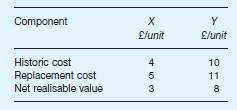1.To be relevant to a particular decision, a cost must have two attributes. What are they?
Distinguish between a sunk cost and an opportunity cost. Define the word ‘cost’ in the context of management accounting.
2. What is meant by the expression ‘committed cost’? How do committed costs arise?
3.Lombard Ltd has been offered a contract for which there is available production capacity. The
contract is for 20,000 identical items, manufactured by an intricate assembly operation, to be
produced and delivered in the next few months at a price of £80 each. The specification for one
item is as follows:
Assembly labour 4 hours
Component X 4 units
Component Y 3 units
There would also be the need to hire equipment, for the duration of the contract, at an outlay
cost of £200,000. The assembly is a highly skilled operation and the workforce is currently under utilised. It is the business’s policy to retain this workforce on full pay in anticipation of high demand next year, for a new product currently being developed. There is sufficient available skilled labour to undertake the contract now under consideration. Skilled workers are paid £15 an hour. Component X is used in a number of other subassemblies produced by the business. It is readily available, and 50,000 units of Component X are currently held in inventories. Lombard Ltd made a special purchase of Component Y in anticipation of an order that did not in the end materialise. It is, therefore, surplus to requirements and the 100,000 units that are currently held may have to be sold at a loss. An estimate of various values for Components X and Y provided by the materials planning department is as follows:

It is estimated that any additional relevant costs associated with the contract (beyond the
above) will amount to £8 an item.
Required:
Analyse the information and advise Lombard Ltd on the desirability of the contract.

